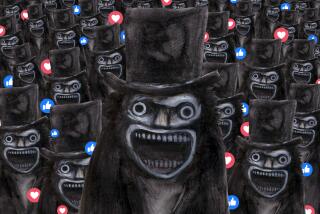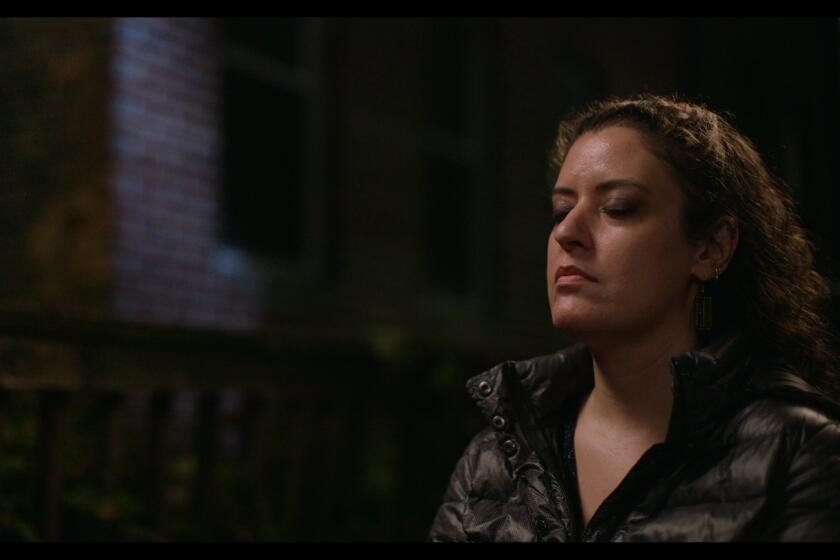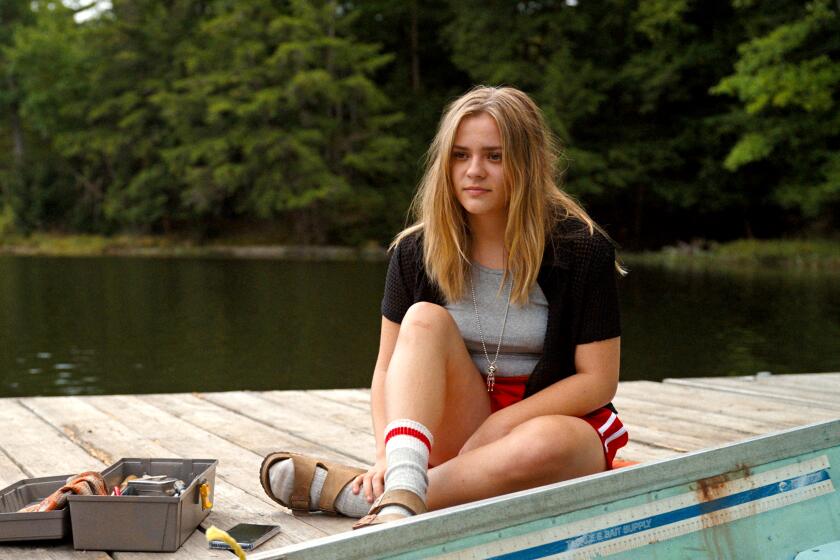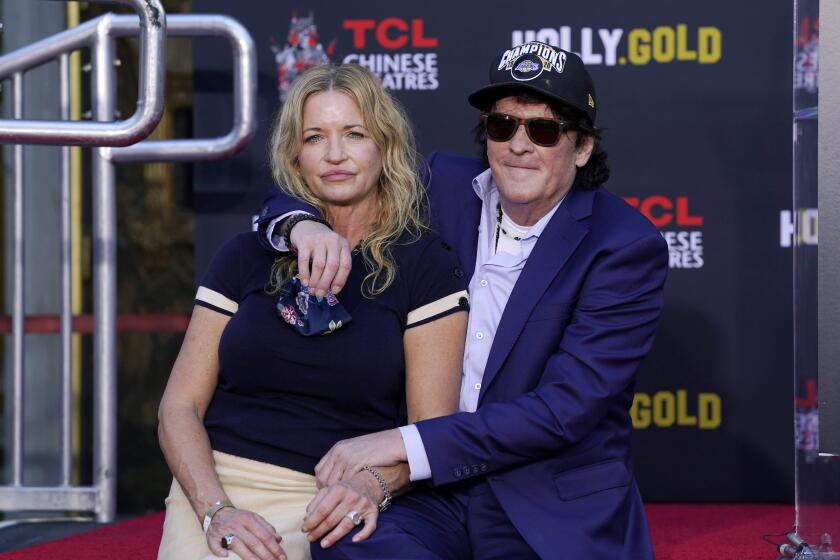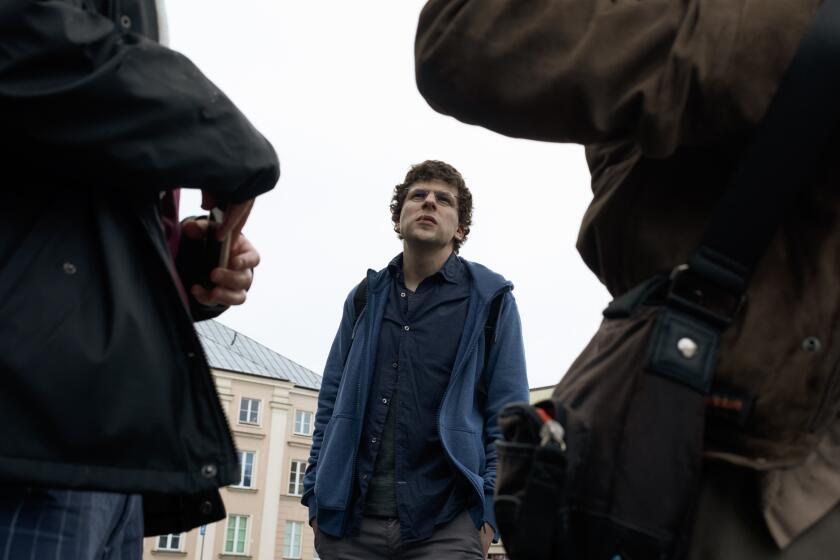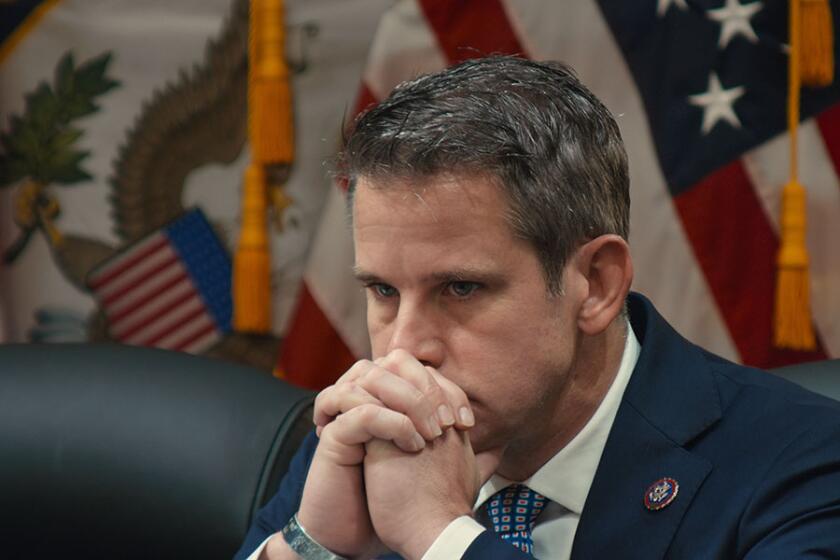Hefner’s first real true love
“You’ve caught me with my pants on,” Hugh Hefner said with a sad smirk. There are days (or entire decades) when Hefner greets the midday sun in silk pajamas and a robe, but on this particular December afternoon, well, the playboy just wasn’t in the mood.
Hefner had arrived back at his 29-room Holmby Hills mansion after attending the funeral of Bettie Page, the pin-up queen, and he was still wearing his mourner’s jacket as he sat and slowly sipped from a bottle of Diet Pepsi in the hush of a downstairs library. Hefner considered Page a friend and fellow pioneer of sorts on the old frontier of American sex culture. Now, like so many others in Hefner’s long journey, she is gone.
“We knew it was coming and there comes a point in the illness. . . .” His voice trailed off and then, adjusting his gold bunny cuff links, he smiled. “We’re not really talking about Bettie Page here today.”
No, but the legacy of desire -- as well as the desire for legacy -- are core concerns for Hefner these days. He has arguably never been more famous, but the glossy centerfold citadel of his empire, Playboy magazine, has struggled, and Hefner, 82, seems most at ease talking about the past and his consuming passion -- no, not that one. According to Hef, Hollywood was actually his first true obsession.
“Everything I learned about love, I learned from the movies,” Hefner said. “The reality is because I was not shown affection, I escaped into an alternate universe, and it came right out of the movies. Love for me is defined almost exclusively in terms of romantic love as defined by the films of my childhood.”
There’s a strong chance that Hefner finally will see a version of himself as a child up on the screen; a long-elusive biographical film is ramping up and, according to Hefner, production could be underway in the next few months. Brian Grazer is the producer, Robert Downey Jr. is keenly interested in the starring role and Brett Ratner has been lined up to direct. Hefner, a devotee of Billy Wilder and Preston Sturges, seemed uncertain about the “Rush Hour” auteur.
“It’s going to be a very curious change of pace for him . . . but I believe in Brian,” Hefner said. “The one thing I would want the film to be is something other than a light comedy, to have something to say and express something about the change in social sexual values. You know, Brian made a comment that I was the only man who had made love to over a thousand women and they all still liked him. And I do take some pride, in fact, that I remain friends with the majority of former wives and girlfriends. I am a romantic.”
Perhaps, but this is the graceless age of Internet porn and Hefner’s magazine has been receding. It celebrated its 55th anniversary in 2008 but, in an unfortunate coincidence, gave pink slips to 55 employees in October. If the glossy print life is stepping down, Hefner’s lifelong fascination for film is moving up among his priorities. The biopic will be co-produced by Playboy’s Alta Loma Entertainment, his production company, which is redoubling its efforts in Hollywood. The company was started in the ‘70s, and after years of making soft-core porn, was a limited partner in August’s “The House Bunny,” a racy but PG-13 farce that starred Anna Faris and Colin Hanks.
Alta Loma is following that up with the R-rated “Miss March,” a comedy about a guy who wakes up from a coma to find his girlfriend as one of Hefner’s playmates. It hits 2,000 theaters in March with Fox distributing. There’s also talk of a live-action version of Little Annie Fanny, the air-headed and bubble-breasted Playboy comic-strip character created for Playboy in 1962 by Mad magazine alums Harvey Kurtzman and Will Elder.
If it all sounds sophomoric, well . . . Hef, like his magazine, has a penchant for flipping between cartoon lewdness and lofty parlor-room pursuits.
Last month, a limo whisked him over to USC where, for the 13th year, he gave a lecture to a cinema censorship class that he seeded with a $100,000 donation. In 1995 he also gave $1.5 million to endow USC’s Hugh M. Hefner Chair for the Study of American Film (held by film historian Richard B. Jewell). He has made major donations to UCLA as well -- $1 million in 2006 to the school’s Film & Television Archive, establishing the Hugh M. Hefner American Film program. And according to Dick Rosenzweig, Hefner’s longtime lieutenant who runs Alta Loma along with Jason Burns, the mogul has quietly funded a number of documentary productions and film preservation efforts. Hefner, who has a “Maltese Falcon” statuette and a bust of Boris Karloff in his bedroom, said all of it is a valentine to his youth.
“It’s my way of trying to pass along some little part of it,” he said. “Movies will never have the same impact that they did when I was a kid. I was fortunate to have been born in 1926 and to have grown up during the Great Depression and war years, to have lived through almost the perfect time frame. For me the boy really is the father of the man.”
The checks written by an aging rich man, though, are gestures, not commitments. Better proof of his celluloid fixation is the crypt he has purchased; when Hefner gives up the ghost, his well-used body will spend eternity in L.A.’s Westwood Memorial Park, next to Marilyn Monroe, a woman he never met, except in the dim light of the movie palace.
--
Childhood influence
Hugh Marston Hefner, born in Chicago on April 9, 1926, grew up on the far west side of town, where the prairie was still part of the horizon. He was a ringleader for the local kids, creating and presiding over elaborate games and drawing an autobiographical comic book called “School Daze” that starred his friends as the supporting cast. He looks back on it as his first success in publishing. At age 16 he also drafted his pals to make a horror movie. His defining ritual as a youngster was taking the streetcar on Grand Avenue (“And,” he says, “it was grand”) to the movies. Some days he sat through a double feature in the afternoon and then another in the evening. Afterward he would carefully record every movie title in his diary.
“The movies, other than family, were the major influence of my childhood,” Hefner said. “I was in a very typical Midwestern, Methodist home with a lot of repression and not much demonstrative expression of emotion. My escape was the darkened theater.”
When it comes to relationships, some men spend their life looking for their mother; Hefner has been searching for leading ladies -- sometimes two or more at a time, like those double-feature days.
“And I think my fascination with blonds is directly connected to the impact that the platinum blonds had in the movies of the 1930s,” he said in a clinical tone. “Jean Harlow, Alice Faye, all of those Busby Berkeley showgirls. You can’t go wrong. Well, you probably could, but what fun.”
For decades, movie screenings have been a tradition at the Playboy mansion. Hefner used to screen two new films every week but, in the 1990s, he surrendered to the fact that the contemporary cinema output just doesn’t yield 104 good movies a year. Now, Friday nights are for new films (“Frost/Nixon” and “Gran Torino” were recent selections) while Sunday nights are for the classics (he screened “Mrs. Miniver” and “I Was a Male War Bride” last month). Hefner devotes “an afternoon I really can’t afford” each week to preparing notes for his introductions of the vintage fare.
On Mondays, it’s Manly Night, in which the audience is smaller and older -- mostly Hefner’s circle of longtime pals, people like tough-guy actor Robert Culp and Ronald Borst, a leading collector of old horror film posters. In recent weeks, they have watched the old “Flash Gordon” serials, which, of course, Hefner remembers in sexual terms. “The women I have been most enamored with over the years,” he says, “looked very much like Dale Arden.”
The old movies stay the same, but the mansion audience doesn’t.
“The group changes by and large only by making new friends and having old friends die,” Hefner said. “Don Adams and Mel Torme used to be part of the group. . . . This literally is a second home for a great many of my friends. I think on my passing a lot of my friends are going to be lost socially.”
--
Refining an image
The Playboy mansion and its master have become symbols of refined debauchery, and Hefner has carefully cultivated that imagery. “The Girls Next Door,” an E! channel show that brought cameras into the mansion (a la “The Osbournes”) to record Hefner’s relationship with a trio of curvy blond girlfriends, began its fifth season in October. A sixth season is on the way and, after much-publicized strife, there is more public interest than ever in the strange love rectangle. There’s also “Mr. Playboy: Hugh Hefner and the American Dream,” the biography by Steven Watts, who was given unrestricted access to the tycoon’s vast archive of self, which includes journals and scrapbooks dating to his youth.
Hefner has a deep voice, an impish grin and the small, delicate hands of man whose mansion has Jergens cherry-almond lotion in every one of its bathrooms. He is not as tall as he used to be and he hunches forward, but the only moment he looks frail is when standing next to the bare-breasted statue of Barbi Benton that lords over his library.
The library shelves are dominated with books on Hollywood history, and it’s surprising, perhaps, that Hefner hasn’t put himself in their pages in a bigger way since moving west in 1971. Like Howard Hughes, he could have bought a spot in the dream factory, but Hefner has mostly been content with just watching.
The great exception to that was his unlikely role as a key producer for Roman Polanski’s grim and gory 1971 “The Tragedy of Macbeth.” A top executive at the Playboy Club in London had championed the idea of Hefner getting involved in the project, which became Polanski’s first film after the 1969 murder of his pregnant wife, Sharon Tate, during the Manson family attacks.
During production, the movie was lagging behind schedule and the company that had insured the film was pushing for Polanski to be replaced.
“I told them, ‘Polanski is our star, he’s the reason we’re making the movie,’ so we gave up the insurance policy and I covered the film myself,” Hefner said. “It was a fascinating film, flawed but fascinating. It was directly related to the murders. There was a moment in which during the murder scene that he misaddressed the actress as ‘Sharon.’ It was such a dark and cathartic project. I only wish I had produced his next film, ‘Chinatown.’ . . .”
But Hefner’s attentions in the 1970s were the massive success of his magazine. The man who started a vast empire with $8,000 and a 1950s vision of a smoking-jacket approach to smut doesn’t dwell on regrets, but he might have made more Hollywood films if he could do it all over. Still, in his mansion, the flicker of old Hollywood looks a lot like twilight memories.
“So much of my life traces back directly to my childhood. Any time I go to Chicago, I always go back and walk the old neighborhood. Much of it is still there. The house I grew up in is still there, but the neighborhood has grown up. When you go back to your old neighborhood and your old home, everything seems smaller than you remember. The only thing that was larger than I remembered it was the movie theater. It seemed bigger than ever.”
--
More to Read
Only good movies
Get the Indie Focus newsletter, Mark Olsen's weekly guide to the world of cinema.
You may occasionally receive promotional content from the Los Angeles Times.
